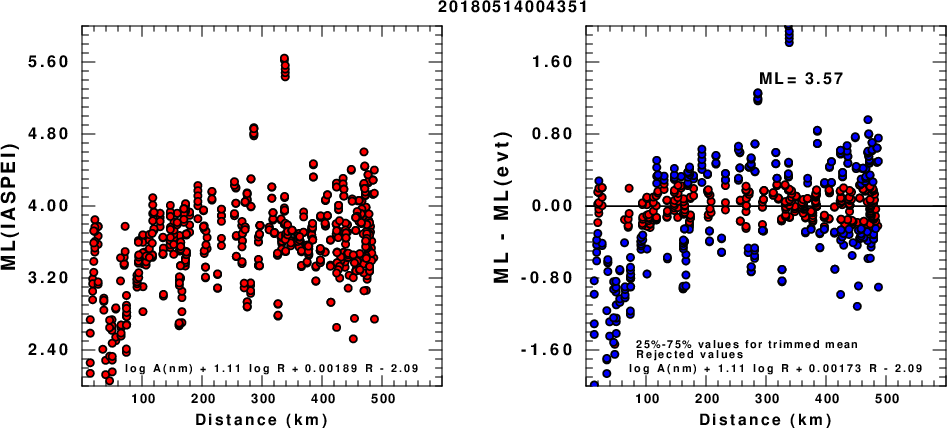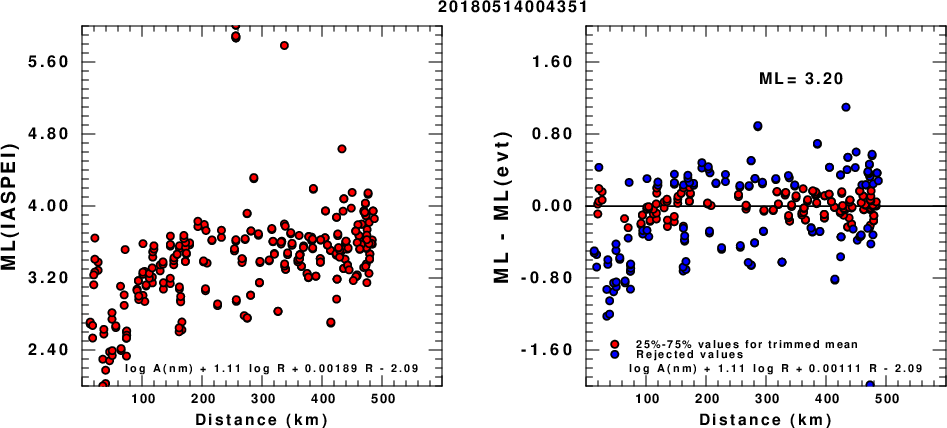Location
Location ANSS
2018/05/14 00:43:51 50.39 12.19 9 4.0 Germany
Focal Mechanism
USGS/SLU Moment Tensor Solution
ENS 2018/05/14 00:43:51:0 50.39 12.19 9.0 4.0 Germany
Stations used:
BW.KW1 BW.MGS04 CH.ROMAN CZ.DPC CZ.GOPC CZ.HSKC CZ.KHC
CZ.PRA CZ.PRU CZ.PVCC CZ.TREC CZ.UPC GE.FLT1 GE.IBBN GE.RUE
GR.AHRW GR.BRG GR.BUG GR.CLL GR.GEC2 GR.GRA3 GR.GRC1
GR.MILB GR.MOX GR.TNS GR.UBBA GR.WET OE.BIOA OE.KBA OE.MOA
OE.MOTA OE.RETA OE.SOKA OE.SQTA OE.WTTA SX.NEUB SX.TANN
SX.WIMM TH.ANNA TH.HKWD TH.HWTS TH.MODW TH.PLN TH.WESF
Filtering commands used:
cut o DIST/3.3 -30 o DIST/3.3 +60
rtr
taper w 0.1
hp c 0.02 n 3
lp c 0.06 n 3
br c 0.12 0.25 n 4 p 2
Best Fitting Double Couple
Mo = 1.29e+21 dyne-cm
Mw = 3.34
Z = 14 km
Plane Strike Dip Rake
NP1 5 80 35
NP2 268 56 168
Principal Axes:
Axis Value Plunge Azimuth
T 1.29e+21 31 232
N 0.00e+00 54 19
P -1.29e+21 16 132
Moment Tensor: (dyne-cm)
Component Value
Mxx -1.82e+20
Mxy 1.05e+21
Mxz -1.22e+20
Myy -7.03e+19
Myz -7.08e+20
Mzz 2.53e+20
---------#####
-------------#########
-----------------###########
------------------############
--------------------##############
---------------------###############
---------------#######---#############
---------##############----------#######
-----##################-------------####
---#####################----------------##
--######################------------------
#######################-------------------
#######################-------------------
######################------------------
####### ############------------------
###### T ############-----------------
##### ###########----------- ---
##################----------- P --
###############------------
##############--------------
##########------------
######--------
Global CMT Convention Moment Tensor:
R T P
2.53e+20 -1.22e+20 7.08e+20
-1.22e+20 -1.82e+20 -1.05e+21
7.08e+20 -1.05e+21 -7.03e+19
Details of the solution is found at
http://www.eas.slu.edu/eqc/eqc_mt/MECH.NA/20180514004351/index.html
|
Preferred Solution
The preferred solution from an analysis of the surface-wave spectral amplitude radiation pattern, waveform inversion and first motion observations is
STK = 5
DIP = 80
RAKE = 35
MW = 3.34
HS = 14.0
The NDK file is 20180514004351.ndk
The waveform inversion is preferred.
Moment Tensor Comparison
The following compares this source inversion to others
| SLU |
USGS/SLU Moment Tensor Solution
ENS 2018/05/14 00:43:51:0 50.39 12.19 9.0 4.0 Germany
Stations used:
BW.KW1 BW.MGS04 CH.ROMAN CZ.DPC CZ.GOPC CZ.HSKC CZ.KHC
CZ.PRA CZ.PRU CZ.PVCC CZ.TREC CZ.UPC GE.FLT1 GE.IBBN GE.RUE
GR.AHRW GR.BRG GR.BUG GR.CLL GR.GEC2 GR.GRA3 GR.GRC1
GR.MILB GR.MOX GR.TNS GR.UBBA GR.WET OE.BIOA OE.KBA OE.MOA
OE.MOTA OE.RETA OE.SOKA OE.SQTA OE.WTTA SX.NEUB SX.TANN
SX.WIMM TH.ANNA TH.HKWD TH.HWTS TH.MODW TH.PLN TH.WESF
Filtering commands used:
cut o DIST/3.3 -30 o DIST/3.3 +60
rtr
taper w 0.1
hp c 0.02 n 3
lp c 0.06 n 3
br c 0.12 0.25 n 4 p 2
Best Fitting Double Couple
Mo = 1.29e+21 dyne-cm
Mw = 3.34
Z = 14 km
Plane Strike Dip Rake
NP1 5 80 35
NP2 268 56 168
Principal Axes:
Axis Value Plunge Azimuth
T 1.29e+21 31 232
N 0.00e+00 54 19
P -1.29e+21 16 132
Moment Tensor: (dyne-cm)
Component Value
Mxx -1.82e+20
Mxy 1.05e+21
Mxz -1.22e+20
Myy -7.03e+19
Myz -7.08e+20
Mzz 2.53e+20
---------#####
-------------#########
-----------------###########
------------------############
--------------------##############
---------------------###############
---------------#######---#############
---------##############----------#######
-----##################-------------####
---#####################----------------##
--######################------------------
#######################-------------------
#######################-------------------
######################------------------
####### ############------------------
###### T ############-----------------
##### ###########----------- ---
##################----------- P --
###############------------
##############--------------
##########------------
######--------
Global CMT Convention Moment Tensor:
R T P
2.53e+20 -1.22e+20 7.08e+20
-1.22e+20 -1.82e+20 -1.05e+21
7.08e+20 -1.05e+21 -7.03e+19
Details of the solution is found at
http://www.eas.slu.edu/eqc/eqc_mt/MECH.NA/20180514004351/index.html
|
Magnitudes
ML Magnitude

(a) ML computed using the IASPEI formula for Horizontal components; (b) ML residuals computed using a modified IASPEI formula that accounts for path specific attenuation; the values used for the trimmed mean are indicated. The ML relation used for each figure is given at the bottom of each plot.

(a) ML computed using the IASPEI formula for Vertical components (research); (b) ML residuals computed using a modified IASPEI formula that accounts for path specific attenuation; the values used for the trimmed mean are indicated. The ML relation used for each figure is given at the bottom of each plot.
Context
The next figure presents the focal mechanism for this earthquake (red) in the context of other events (blue) in the SLU Moment Tensor Catalog which are within ± 0.5 degrees of the new event. This comparison is shown in the left panel of the figure. The right panel shows the inferred direction of maximum compressive stress and the type of faulting (green is strike-slip, red is normal, blue is thrust; oblique is shown by a combination of colors).
Waveform Inversion
The focal mechanism was determined using broadband seismic waveforms. The location of the event and the
and stations used for the waveform inversion are shown in the next figure.

|
|
Location of broadband stations used for waveform inversion
|
The program wvfgrd96 was used with good traces observed at short distance to determine the focal mechanism, depth and seismic moment. This technique requires a high quality signal and well determined velocity model for the Green functions. To the extent that these are the quality data, this type of mechanism should be preferred over the radiation pattern technique which requires the separate step of defining the pressure and tension quadrants and the correct strike.
The observed and predicted traces are filtered using the following gsac commands:
cut o DIST/3.3 -30 o DIST/3.3 +60
rtr
taper w 0.1
hp c 0.02 n 3
lp c 0.06 n 3
br c 0.12 0.25 n 4 p 2
The results of this grid search from 0.5 to 19 km depth are as follow:
DEPTH STK DIP RAKE MW FIT
WVFGRD96 1.0 355 90 0 3.02 0.2873
WVFGRD96 2.0 0 90 0 3.10 0.3581
WVFGRD96 3.0 180 80 -10 3.14 0.3731
WVFGRD96 4.0 0 90 55 3.29 0.4033
WVFGRD96 5.0 175 85 -55 3.31 0.4294
WVFGRD96 6.0 175 85 -50 3.29 0.4395
WVFGRD96 7.0 175 90 -45 3.29 0.4465
WVFGRD96 8.0 0 85 50 3.33 0.4524
WVFGRD96 9.0 5 80 45 3.32 0.4560
WVFGRD96 10.0 5 80 45 3.33 0.4609
WVFGRD96 11.0 10 75 45 3.34 0.4642
WVFGRD96 12.0 5 80 40 3.33 0.4663
WVFGRD96 13.0 10 75 40 3.34 0.4668
WVFGRD96 14.0 5 80 35 3.34 0.4669
WVFGRD96 15.0 5 80 35 3.35 0.4659
WVFGRD96 16.0 5 80 35 3.36 0.4636
WVFGRD96 17.0 5 80 35 3.36 0.4603
WVFGRD96 18.0 180 90 -30 3.36 0.4526
WVFGRD96 19.0 5 85 30 3.37 0.4524
WVFGRD96 20.0 180 90 -30 3.38 0.4449
WVFGRD96 21.0 5 85 30 3.38 0.4429
WVFGRD96 22.0 5 85 30 3.39 0.4374
WVFGRD96 23.0 5 85 30 3.39 0.4312
WVFGRD96 24.0 5 85 30 3.40 0.4248
WVFGRD96 25.0 5 85 30 3.40 0.4181
WVFGRD96 26.0 5 85 30 3.41 0.4110
WVFGRD96 27.0 5 85 30 3.41 0.4039
WVFGRD96 28.0 5 85 30 3.42 0.3969
WVFGRD96 29.0 5 85 30 3.42 0.3899
The best solution is
WVFGRD96 14.0 5 80 35 3.34 0.4669
The mechanism correspond to the best fit is

|
|
Figure 1. Waveform inversion focal mechanism
|
The best fit as a function of depth is given in the following figure:

|
|
Figure 2. Depth sensitivity for waveform mechanism
|
The comparison of the observed and predicted waveforms is given in the next figure. The red traces are the observed and the blue are the predicted.
Each observed-predicted component is plotted to the same scale and peak amplitudes are indicated by the numbers to the left of each trace. A pair of numbers is given in black at the right of each predicted traces. The upper number it the time shift required for maximum correlation between the observed and predicted traces. This time shift is required because the synthetics are not computed at exactly the same distance as the observed and because the velocity model used in the predictions may not be perfect.
A positive time shift indicates that the prediction is too fast and should be delayed to match the observed trace (shift to the right in this figure). A negative value indicates that the prediction is too slow. The lower number gives the percentage of variance reduction to characterize the individual goodness of fit (100% indicates a perfect fit).
The bandpass filter used in the processing and for the display was
cut o DIST/3.3 -30 o DIST/3.3 +60
rtr
taper w 0.1
hp c 0.02 n 3
lp c 0.06 n 3
br c 0.12 0.25 n 4 p 2

|
|
Figure 3. Waveform comparison for selected depth
|

|
|
Focal mechanism sensitivity at the preferred depth. The red color indicates a very good fit to thewavefroms.
Each solution is plotted as a vector at a given value of strike and dip with the angle of the vector representing the rake angle, measured, with respect to the upward vertical (N) in the figure.
|
A check on the assumed source location is possible by looking at the time shifts between the observed and predicted traces. The time shifts for waveform matching arise for several reasons:
- The origin time and epicentral distance are incorrect
- The velocity model used for the inversion is incorrect
- The velocity model used to define the P-arrival time is not the
same as the velocity model used for the waveform inversion
(assuming that the initial trace alignment is based on the
P arrival time)
Assuming only a mislocation, the time shifts are fit to a functional form:
Time_shift = A + B cos Azimuth + C Sin Azimuth
The time shifts for this inversion lead to the next figure:

The derived shift in origin time and epicentral coordinates are given at the bottom of the figure.
Discussion
Acknowledgements
Thanks also to the many seismic network operators whose dedication make this effort possible: University of Nevada Reno, University of Alaska, University of Washington, Oregon State University, University of Utah, Montana Bureas of Mines, UC Berkely, Caltech, UC San Diego, Saint Louis University, University of Memphis, Lamont Doherty Earth Observatory, the Iris stations and the Transportable Array of EarthScope.
Velocity Model
The WUS.model used for the waveform synthetic seismograms and for the surface wave eigenfunctions and dispersion is as follows:
MODEL.01
Model after 8 iterations
ISOTROPIC
KGS
FLAT EARTH
1-D
CONSTANT VELOCITY
LINE08
LINE09
LINE10
LINE11
H(KM) VP(KM/S) VS(KM/S) RHO(GM/CC) QP QS ETAP ETAS FREFP FREFS
1.9000 3.4065 2.0089 2.2150 0.302E-02 0.679E-02 0.00 0.00 1.00 1.00
6.1000 5.5445 3.2953 2.6089 0.349E-02 0.784E-02 0.00 0.00 1.00 1.00
13.0000 6.2708 3.7396 2.7812 0.212E-02 0.476E-02 0.00 0.00 1.00 1.00
19.0000 6.4075 3.7680 2.8223 0.111E-02 0.249E-02 0.00 0.00 1.00 1.00
0.0000 7.9000 4.6200 3.2760 0.164E-10 0.370E-10 0.00 0.00 1.00 1.00
Quality Control
Here we tabulate the reasons for not using certain digital data sets
The following stations did not have a valid response files:
Last Changed Mon May 14 10:49:26 CDT 2018








